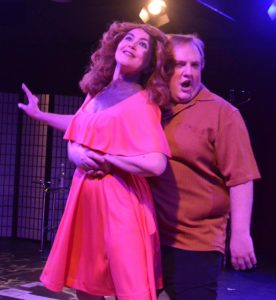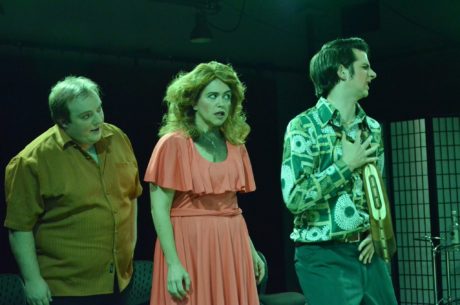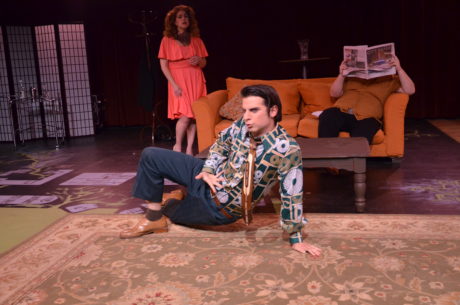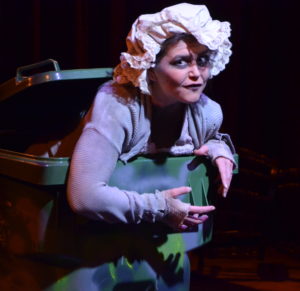Max Garner’s Rapid Lemon Productions (“Rapid Lemon”) is pairing two short Absurdist Theater gems to create an evening of darkly-humorous nihilism at the Motor House performance space. And, like me, it seems that they like their existential crises to have an Irish accent; both plays – Darren Donohue’s campy Voices in the Rubble (“Voices”) and Samuel Beckett’s classic Endgame – were penned by playwrights from the Emerald Isle.
Voices in the Rubble
“I think I love you most when you cry.”
Playwright Darren Donohue has been winning awards and having his plays produced around Europe for years now, but he has only recently started to become known in the US. Last year, Donohue’s play, Tuesday Evening (following the news), was performed in New York and DC as part of The Kennedy Center’s “Tiny Plays for Ireland/America” project. Now, his award-winning one-act, Voices in the Rubble (Best Overall Production, Dramafest 2015), is celebrating its US premiere at Rapid Lemon Productions.

About Voices, Donohue says, “It’s about the highs and lows, the agony and the ecstasy, all that happens when you tie – or chain – your life to somebody else’s.” While I reckon Donohue knows what his own play is about, his quote doesn’t really prepare you for what awaits you in this modern Absurdist romp.
Voices is dark, funny, and weird AF (in a good way). Sure, it’s about a married couple, but the experiences they have – their “highs and lows” as Donohue put it – are a far cry from those of your average Joe. Murder, marital infidelity, mistaken identity, and sexual misconduct mark the world of this couple who, all the while, seem unphased by the mayhem. It feels like what would result if Leave It to Beaver and one of those super-intense telenovela soap operas had a baby, complete with melodramatic organ music and a gasp-track, courtesy of Sound Designer Patrick McMinn.
Rapid Lemon’s production is innovatively directed by the multi-talented Lance Bankerd, who also plays a role in both shows on the double-bill. Bankerd elicits excellent performances from the talented cast he’s assembled. These actors have what it takes to keep up with Donohue’s quick, clever dialogue, as well as the series of absurdities his characters endure.
In Voices, Bankerd plays the small-but-pivotal part of Man. What he lacks in stage time, he makes up for with impact. And he’s got one of the best stage entrances I’ve seen.
Zack Jackson is great as Tony, with a big, smooth, game show announcer voice and a confident, optimistic demeanor to match. He delivers bizarre, outrageous lines with such sincerity, it’s impressive that he and his castmates make it through the production without bursting into laughter. Both Jackson and his character are unflappable.
Lee Conderacci plays Avril, Tony’s lovely, though absentminded, wife. She kills it. She affects a wonderful, thorazine-soaked voice and employs an awesome array of facial expressions to bring Avril to life. When she vacantly announces, “I’m finding it hard to know what I want today” – and variations thereof – you’re inclined to believe her.

Rounding out the cast is Matthew Lindsay Payne, as George. The whole show is greatly enhanced by fantastic physical comedy by all, but Payne takes it to the next level. From his dramatic entrance until he leaves the stage, Payne is a hilarious ball of comedic energy. With acting skills as spot-on as his physical performance, Payne’s portrayal of George is first-rate.
Scenic Designer Sebastian Sears’s set is like the soundstage for a 1950s sitcom. Or perhaps a 1970s sitcom about the 1950s. It’s got bright bold colors – an orange sofa, a green refrigerator – and some subtler touches like a faded Persian rug and the obligatory 50’s-era booze cart for preparing cocktails. The set was complemented beautifully by Lighting Designer Allan Sean Weeks’s artful illumination and Sound Designer McMinn’s upbeat, soap-operiffic score.
Costume Designer Deana Fisher Brill outfitted the cast in the spirit of the sitcom world. My favorite costume piece was Matt Payne’s shirt. The color (GREEN!) and the pattern (LOUD!) were fantastically outdated, recalling a parade of 60’s and 70’s-era characters like Mr. Furley from Three’s Company to pretty much anyone on The Brady Bunch.
The set made a great backdrop for a series of tableaus throughout the production. The cast would periodically assume iconic or familiar positions such as Tony dipping Avril, dancer-style, or the couple, cheek-to-cheek, each with a leg bent at the knee like a pin-up girl kissing a sailor in an old movie. The actors would momentarily freeze in these striking positions as if a snapshot were being taken or they were about to go to a commercial break. The tableaus are a terrific little bonus that amplify the unreality of the outrageous events occurring onstage.

Voices in the Rubble was a tasty comic appetizer to savor before being served the bleak entrée of Beckett’s Endgame. But first…
Intermission
During intermission, the dining table from Voices was moved center stage and the actors, in robes and chatting among themselves, took seats around it. They were joined by Costume Designer Deana Fisher Brill and her cool Doc Martin-wearing, milkmaid-braided daughter, who helped the actors – particularly the physically-transformed Payne – with their makeup.
The choice to transition the actors’ appearances onstage at the same time the set was being changed between the shows was a good one. As the cast evolved from sock-hop era saccharine to post-apocalyptic pallor, McMinn’s sound design also progressively darkened from cheery melodies to an eerie composition. It was a good way to ease the audience from one absurdist universe into another.
Endgame
“Nothing is funnier than unhappiness.”
Samuel Beckett was not known for his fun-loving whimsy. Nor for his flexibility when it came to the production of his plays. In 1984, the American Repertory Theater staged Endgame, using an inventive set that designer JoAnne Akalaitis envisioned – a derelict, litter-strewn subway station. Beckett insisted the programs for the show include this message from him:

“Any production of Endgame which ignores my stage directions is completely unacceptable to me. My play requires an empty room and two small windows. The American Repertory Theater production which dismisses my directions is a complete parody of the play as conceived by me. Anybody who cares for the work couldn’t fail to be disgusted by this.”
Scenic Designer Sebastian Sears appears to have opted against riling the ghost of the cranky Irishman. Following Beckett’s directions, the set for Rapid Lemon’s production is spare. In coordination with Stage and Properties Manager Gretchen Hylton, Sears’ set consists of a bare room with two small windows and a step ladder. Two of the characters reside in rubbish bins and a third is in a makeshift wheelchair. Even when everyone is onstage, the set is still mostly an empty room.
One notable difference from the traditional staging of Endgame involves the lighting design. Instead of the dull gray dimness one might expect, Lighting Designer Allan Sean Weeks uses orange gels to create the feeling of an underground bunker on backup power. It’s a subtle, but wonderful, choice that – along with age-worn props and filthy, mismatched costumes – makes the whole place seem like you’re inside the game Fallout.

With no announcement or fanfare, Endgame begins with Clov, played by Matthew Lindsay Payne, entering the stage pushing a shopping cart full of random junk. The front row gets to know Payne a little better as he changes from his ‘outside’ outfit of gas mask, hat, jumpsuit, rain boots, etc. to his costume for the balance of the show – filthy t-shirt, boxers, tall socks, rain boots. Costumer Deana Fisher Brill really outdid herself in Endgame. The clothes that the actors wear legitimately look like they’ve survived decades of constant wear and, perhaps, a nuclear winter.
After spending an extended period changing clothes, checking the windows, and readying the room, Payne brings the rest of the cast onstage. The hour that follows is an almost comfortless study in meaninglessness, cruelty, futility, and decay. Lucky for us, Director Lance Bankerd finds the laughs in Beckett’s nihilistic tale of four people – Hamm, the one giving the orders; Clov, the resentful-but-obedient servant; and Nell and Nagg, Hamm’s parents. This is a quartet of folks who wonder “Do you not think this has gone on long enough?” “This” being their lives, the unasked-for gift they are painfully enduring as they wait impatiently for death.
Much of the humor is physical, such as when Clov whack-a-moles Nagg as he tries to push open lid of the trash can he lives in. There’s also some welcome levity in the many self-conscious asides and addresses to the audience, such as when Hamm declares, “I’m warming up for my last soliloquy.” And I found comfort in the grim interdependence of the quartet – two characters are legless, another can neither see nor walk, and the last cannot sit or bend one of his legs. Just like in real life, whether we acknowledge it or not, we need one another to survive.
Zack Jackson plays Hamm, the blind and wheelchair-bound tyrant who is the head of this peculiar household. Unlike in Voices, Jackson’s role requires him to leave physical comedy at the door. Even his facial expressions are obscured; he wears dark glasses nearly all the time. Still, with only his voice, a whistle, and a few hand gestures, Jackson gives a robust performance as the unsympathetic bully.
Hamm’s parents, Nell and Nagg are played by Lee Conderacci and Lance Bankerd, respectively. Both actors spend the entirety of the play inside of trash cans – mostly with the lids closed – but nonetheless manage to make a strong impression. When they are visible, they are wearing pajamas – she in a sleeping bonnet and he in a night cap – looking like a post-apocalyptic version of the parents in a cheery Christmas story.

In her second skillful performance of the night, Conderacci is charming as Nell. She is especially good when Nell dreamily reminisces with Nagg about when they were young and spent time riding a tandem bike or rowing on Lake Como. Bankerd also makes the very most of his brief time onstage, presenting not only Nagg’s gruff bitterness aimed at Hamm, but also a refreshing tenderness for Nell.
It’s high praise considering the excellent caliber of his fellow actors, but honestly, the night belongs to Matthew Lindsay Payne. After his kitschy comedic turn as George in Voices, Payne is nearly unrecognizable as Hamm’s longsuffering servant, Clov. The physical challenge of performing an entire play without bending your leg must be exhausting. The energy Payne expends the numerous times Clov must pick something up from the floor, move Hamm’s wheelchair, or climb a ladder is visible.
Yet that’s just the foundation for his character. Layered on top are the ingredients that make Payne’s portrayal of Clov superlative. His acting is solid. His timing, spot-on. His posture and gestures attest to the physical and spiritual pain Clov endures and his gritty voice sounds like a combination of Igor, Smeagel, and Mr. Croup. Even his silences are expressive. These two Irish plays could’ve been custom-built to display Payne’s impressive range.
~~~
Voices in the Rubble and Endgame couple well together, are performed by an outstanding ensemble cast, and are supported by a clever creative team. The plays showcase the talent each of the actors possesses, as well as the expert light, sound, set, and costume designers that brought the worlds of the plays into physical form.
If you’re unfamiliar with Absurdist theater, Rapid Lemon’s double-feature will make an excellent introduction. If you are a fan of absurdism already, don’t pass up this opportunity to see the US premiere of Voices in the Rubble and genre-definer Samuel Beckett’s classic of existential ennui, Endgame. Either way, start making plans to attend one of the three remaining performances of this Rapid Lemon triumph.
Running Time: Two hours and 20 minutes, including an intermission.
Endgame and Voices in the Rubble play through May 21, 2017 at Rapid Lemon Productions performing at Motor House, 120 West North Avenue in Baltimore, MD. For tickets, purchase them at the box office or online.
NOTE: The May 20th performance of this production will be ASL-interpreted for the hearing impaired.




